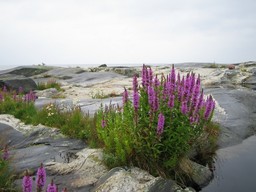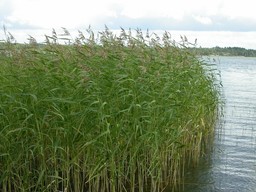15. The Baltic Sea
Contents
15.1 What is the Baltic Sea like?
 The Baltic Sea is an inland sea. Hundreds of rivers flow into the Baltic Sea, filling it with fresh water. However, the Baltic Sea also receives high-salt seawater from the North Sea. As these two water types are combined, the result is a water type called brackish water. Brackish water is low in salt, with a salt concentration of a few promilles (thousandths). This is quite low when compared to the salt concentration of 3,5 percent found in the major oceans.
The Baltic Sea is an inland sea. Hundreds of rivers flow into the Baltic Sea, filling it with fresh water. However, the Baltic Sea also receives high-salt seawater from the North Sea. As these two water types are combined, the result is a water type called brackish water. Brackish water is low in salt, with a salt concentration of a few promilles (thousandths). This is quite low when compared to the salt concentration of 3,5 percent found in the major oceans.
The Baltic sea is also quite shallow. As a result, it contains relatively little water compared to other seas.
The Baltic Sea is exceptional in many respects. For one, it is a relatively young sea, being formed after the last ice age some 10 000 years ago.
The Baltic Sea is also special due to the fact that it is the largest shallow brackish water pool of its kind in the world. In addition to this, the plants and animals of the Baltic Sea are unique as they have had to adapt to the fact that the sea freezes over during most winters.
The catchment area of the Baltic Sea (the area from which water flows into the Baltic) is home to over a hundred million people. As a result, organisms also have to adapt to the changes brought into their environment by human activity.
15.2 The Baltic Sea as a living environment
The variation in salt concentration among different parts of the Baltic Sea results in different species favouring different areas. In the southern parts of the Baltic, where the salt concentration is as high as one percent, the species are mostly the same as in the North Sea. In these parts, ocean-dwelling species such as starfish and crabs can be found. In the Gulf of Finland and the Gulf of Bothnia the salt concentration is under 0,5 %. These gulf areas are the home of lake-dwelling species that have adapted to the brackish water of the Baltic.
The conditions of the Baltic Sea are challenging for living organisms. For example, most fish species of the Baltic are not adapted to high salt concentrations, which means that they are often in the danger of acquiring too much salt in their systems. The long winter and the frozen gulfs also make life in the Baltic Sea quite challenging for organisms.
 The Baltic Sea freezes over partially during the winter.
The Baltic Sea freezes over partially during the winter.15.3 Food chains of the Baltic Sea
The Baltic Sea is the home of tens of fish species, and its islands are inhabited by a variety of different birds. But what do all of these animals eat?
The food chain always begins at the level of producers – small algae and cyanobacteria, and larger plants. Large plants do not grow on the open Baltic, which means that algae are the sole producers of these areas. As algae are microscopically small and flow freely in the water, they are considered pythoplankton.
The numbers of blue algae, green algae and diatom algae begin to increase during the spring, when the ice cover has melted and the increasing amount of sunlight makes photosynthesis possible. In addition to sunlight, the algae also require nutrients, such as nitrogen and phosphorous. During the spring, these nutrients are plentiful, and the algae make use of this by reproducing with great speed.
The group of zooplankton consists of microscopic organisms such as water fleas and copepods. Zooplankton are consumers that eat producer algae. In turn, these zooplankton are the food of small fish species such as the herring. The top of the food chain of the Baltic sea is inhabited by predators such as the pike, the white-tailed eagle, and the Baltic ringed seal.

Consumers in the food chain of the Baltic Sea. Zooplankton (pictured: copepod) eats microscopic algae. Herrings eat zooplankton and larger fishes, such as the pike, eat herrings. Ringed seals are fourth degree consumers.
Bladderwrack or kelp is a key species of the Baltic Sea.
15.4 Species of the Baltic Sea
15.5 The Baltic Sea must be protected
There are many reasons for why we should protect the Baltic Sea. The most important of these reasons is that the Baltic Sea is an exceptional environment that is home to a unique combination of both saltwater and freshwater species.
The bird species of the Baltic are also exceptional. The Baltic Sea is the nesting place for tens of bird species, and millions of birds migrate through it to reach their northern nesting areas.

The Baltic Sea is also important for humans. The Baltic Sea is an important fish producer. During the recent years, the practice of breeding fish in artificial pools has grown more common in the Baltic. In addition to professional fishing, the Baltic also provides a popular destination for recreational fishers. The Baltic is also a popular location for other recreational activities.
The need for protecting the Baltic is urgent. The Baltic Sea is threatened by many problems, all of which are caused by humans. These threats include microplastics, eutrophication, and chemical and oil leaks from industrial activity. Because the Baltic Sea is very relatively shallow, even small amounts of harmful substances can be very dangerous to its ecosystems.
The nations of the Baltic Sea have made multiple agreements aiming to protect the Baltic Sea. These agreements try to limit the harmful effect of humans on the environment. However, there is still an urgent need to protect the nature of the Baltic Sea more efficiently.

A large cruise ship travelling through the Finnish archipelago. Cormorants are sitting on the islet in the front. The increase of shipping traffic in the Baltic is one of the threats to the sea's ecosystem.










